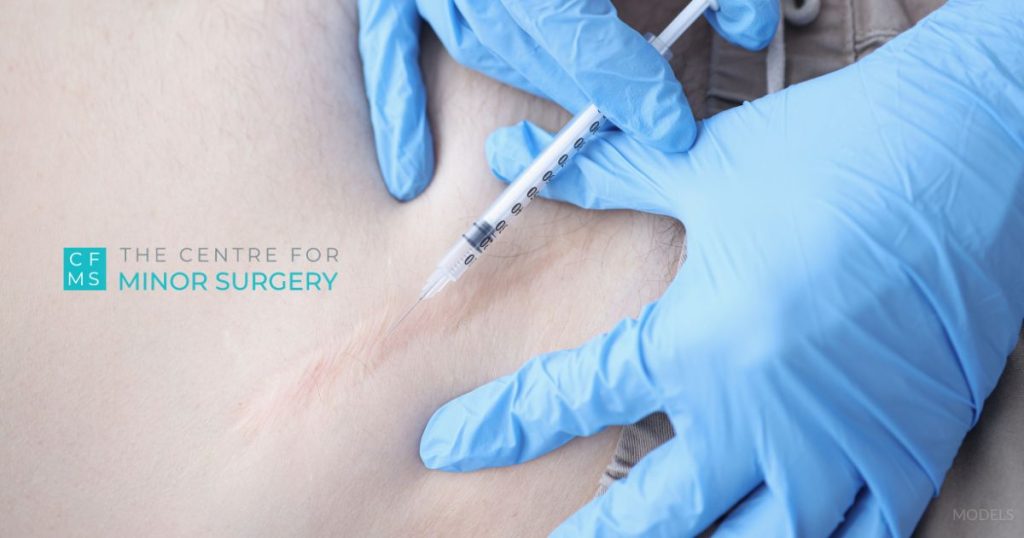If you’ve developed a raised scar that extends past your original wound (whether it be a surgical scar, piercing, or run-of-the-mill cut), you might have a keloid. This abnormal-looking rapid growth of tissue can be unsightly and sometimes even uncomfortable. Even though surgery can remove keloids, they often recur. Keloid injection treatments are a valuable tool in managing keloids, particularly after surgical excision.
What Is a Keloid Scar?
Keloids are abnormal scars that develop when the body produces excessive collagen during healing. Unlike normal scars, a keloid grows beyond the boundaries of the original injury, creating a raised and brown, red, or purplish growth on the skin.
Keloids form after various types of skin trauma, including:
- Surgical incisions
- Piercings
- Acne
- Burns
- Cuts or scrapes
Certain people are more prone to developing keloids, particularly those with darker skin tones of African, Asian, and Hispanic descent. Keloids are also more likely to form in certain areas of the body, such as the chest, shoulders, and earlobes. You can get answers to 6 common questions about how to get rid of keloid scars in our previous blog post.
Should You Have Surgery To Remove a Keloid Scar?
If your keloid makes you self-conscious because of its size or if it is just particularly bothersome, surgical excision is an option. Our Royal College-certified plastic surgeons carefully remove the keloid tissue, sometimes using reconstructive techniques to minimize scarring after the procedure. However, keloids have a high rate of recurrence after excision alone, with current research showing recurrence rates ranging from 45% to 100%.
This high recurrence rate is why we often recommend patients combine surgical excision with other treatments, such as injection therapies, to improve outcomes and reduce the likelihood of keloid regrowth.
Keloid Steroid Injection Treatments
Injection treatments play a crucial role in keloid management, both as a standalone therapy and when combined with surgical excision. These treatments typically involve injecting medications directly into the keloid or the surgical site to prevent recurrence.
Cortisone injections are the most widely used injection treatment for keloids. These injections work by:
- Reducing inflammation
- Decreasing collagen synthesis
- Increasing collagen breakdown
- Inhibiting fibroblast growth
Our surgeons typically administer cortisone injections immediately after surgical excision and then repeat them at regular intervals, typically every 3 to 4 weeks, for several months. This approach significantly reduces keloid recurrence rates compared to excision alone.
Studies have shown that combining cortisone injections with surgical excision is highly effective. Potential side effects of the combination treatment include thinning skin (skin atrophy), hypopigmentation, and telangiectasia (visible blood vessels). However, our surgeons minimize these risks using appropriate doses and injection techniques.
Factors Influencing Treatment Success
Several factors can influence the success of keloid injection treatments:
- Timing: Starting injection treatments immediately after excision or at the first sign of keloid formation can improve the results.
- Consistency: Regular, scheduled injections are essential for optimal results.
- Individual characteristics: Your skin type, age, and overall health can affect treatment response.
- Keloid characteristics: The keloid’s size, location, and age can influence treatment outcomes.
Your healthcare provider’s technique matters too. Choosing a provider who uses a proper injection technique, including the correct depth and distribution of the medication, increases the effectiveness and minimizes side effects.
Complementary Treatments
Keloid management often includes other therapies in conjunction with injections, such as:
- Pressure therapy: Applying pressure to the treated area can prevent keloid recurrence.
- Silicone sheets or gels: These products may reduce keloid formation when used consistently.
- Radiation therapy: In some cases, low-dose radiation may be used after excision to prevent keloid recurrence.
- Cryotherapy: Freezing the keloid tissue can be effective, especially when combined with other treatments.
While no single treatment guarantees complete keloid eradication, the combination of surgical excision and targeted injection therapies has significantly improved the prognosis for many individuals struggling with keloids.
How Much Does Keloid Scar Treatment Cost?
The cost of treating a keloid scar depends on several factors, including the size and location of the scar and the treatment options you choose. The Centre for Minor Surgery’s pricing page provides more information on costs.
If you’re bothered by a keloid scar and want to learn more about your treatment options, request a consultation using the online form to meet with one of our plastic surgeons. Or call us at (416) 663-9649 to schedule an appointment.


Leave a Reply